City guides


Charleston Travel Guide
Charleston is one of the loveliest cities in the country, despite having weathered great fires, earthquakes, epidemics, civil war, and a devastating hurricane. It is consistently classed among the most elegant and picturesque cities nationwide.
The port of Charleston is the oldest city in the state, sat on the peninsula separated by the Ashley and Cooper Rivers. A large downtown district boasts hundreds of preserved and restored buildings built over brick and cobblestone streets, housing old-fashioned inns, antique shops, and pubs.
Narrow houses festooned with wrought-iron balconies and wooden shutters line the streets, and ornate gates enclose pretty gardens and shaded porches. Many of its double-storey houses are authentically furnished museums that once belonged to wealthy colonial merchants, while many are still the beautiful private homes of wealthy residents.
The city started as an important seaport serving the rice and cotton plantations throughout the region. It was a major slave-trading centre with about a third of America's slaves being bought and sold at the riverfront market.
Populated by ancestors of West African slaves, the Gullah culture of the islands has a tangible presence. This is especially evident at the Old City Market that vibrates with the humming of traditional spirituals, local vendors, iron makers, basket ladies, and distinctive Gullah dialects.
Things to do in Charleston
To holiday in Charleston is to travel back in time to the Old South. This lovely city preserves the ambience and distinctive architecture of its past, boasting fascinating historic sites and buildings, including forts, museums and old plantations with picturesque mansions and sprawling gardens.
Those who travel to Charleston will leave with a better understanding of the historic slave trade and the Civil War, the first shots of which were fired in Charleston at Fort Sumter. Visitors will most likely also leave with plenty of unique souvenirs picked up at the popular riverside market.
The best time to travel to Charleston is during spring (April and May), when the city is in bloom and the weather is dry, warm, and sunny. Most rain falls during the summer months (June to August) when thunderstorms are common. During autumn, there's the threat of hurricanes while winter is short but chilly.
A holiday in Charleston is best suited for those who enjoy sightseeing and soaking up history in a laidback manner, whether in a horse-drawn carriage or on a walking tour. A Charleston holiday is educational and fun for children, with the South Carolina Aquarium a particular drawcard for kids.
The city is compact and much of it is comfortably explored on foot or by hired bicycle, adding another element of fun and freedom for the whole family.
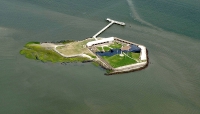
Fort Sumter
Situated on a small manmade island in the bay, the Fort Sumter National Monument guards the entrance to Charleston Harbour. It's one of the most important historic military sites in the country, built using 70,000 tons of granite and rock brought from as far afield as New York City. The first shots of the American Civil War were fired at Fort Sumter in 1861. With the secession of South Carolina, the Confederates demanded the surrender of the fort and after 34 hours of continuous bombardment, the Union forces had no choice but to relinquish their hold. The Union troops became the first prisoners of the Civil War. The fort became a symbol of resistance until it was retaken by Union forces in 1865 after nearly four years of continual attack, reducing most of the fort to rubble. Park rangers conduct free tours around the restored structure, which includes a museum with historical displays.
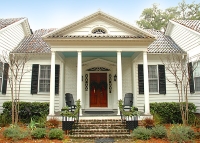
Plantations
Magnificent plantations sit along the Ashley River and the highway towards Georgetown, the main attraction being Boone Hall Plantation. A majestic oak avenue leads to the estate, where travellers can visit the original slave quarters, cotton gin house, and the mansion, furnished and decorated according to the period. Still near the river and closest to Charleston, Drayton Hall is the oldest preserved plantation house in the USA. Dating from 1742, the Georgian masterpiece is a National Historic Landmark and the only plantation house on the Ashley to survive the Civil War intact. Conversely, Middleton Place was largely destroyed. But the south wing has been restored and contains an impressive collection of historic documents, silver, furniture, and paintings. Interestingly, its grounds are the oldest landscaped gardens in the country, designed in 1741. The estate also boasts stable yards filled with heritage breeds of cows, goats, pigs, and chickens. The ornamental lakes and surrounding gardens are home to roaming peacocks and other farm animals. Magnolia Plantation was founded in 1676 by the Drayton family. The plantation opened its doors to the public in 1870, allowing all comers to view the gardens. It thus became the oldest public garden in the country.
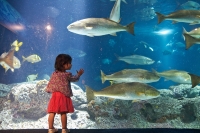
South Carolina Aquarium
Charleston's most visited attraction, the South Carolina Aquarium features thousands of amazing aquatic animals. These include river otters, sharks, and loggerhead turtles in over 60 exhibits, representing the rich biodiversity of South Carolina from the mountains to the sea. The aquarium also affords visitors fabulous views of Charleston Harbor, and there are daily interactive exhibits and programmes for guests of all ages. Every visit reveals something new, with glimpses of new animals, budding plants, baby animals, and more. The institution provides a variety of opportunities to learn about conservation, animal life, endangered species, and environmental issues. It also houses creatures from further afield, with different exhibits illustrating various habitats. South Carolina Aquarium is involved in a few initiatives too, such as Good Catch. Organisers hope to foster awareness in the community around responsible harvesting and consumption of local seafood. They work with restaurants, fisheries, and caterers, in an attempt to protect the ocean.
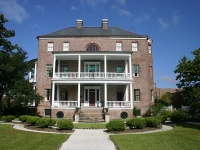
Charleston Museum
Founded in 1773, the Charleston Museum opened while the United States was still a British colony. It encompasses three historic buildings, aiming to preserve the unique culture and natural history of Charleston and the surrounding South Carolina Lowcountry. Exhibitions include cultural, historic, and natural artefacts, alongside two National Historic Landmark houses: the Heyward-Washington House and Joseph Manigault House. They are good representations of the graceful architecture and wealthy lifestyles of days gone by. Daniel Heyward built the Heyward-Washington House for his son, Thomas Heyward, who was among those who signed the Declaration of Independence. George Washington stayed here during a weeklong visit to Charleston, giving the house its name. Joseph Manigault House is a clear example of Federal architecture, influenced by the French Huguenots who moved to America to escape religious persecution. Both houses are furnished and decorated to appear as they would have done in the 1700s.
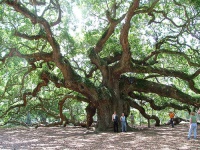
Angel Oak
Angel Oak is thought to be one of the oldest oak trees east of the Mississippi River. This extraordinary live oak is between 400 and 500 years old and boasts a vast canopy in excess of 17,000 square feet, despite it not being very tall. It's survived countless hurricanes, floods, and earthquakes, including severe damage from Hurricane Hugo in 1989. The tree's forest home may have been one of the islands' many lumber sources for ship-building back in the 18th century, yet nowadays the park and tree are owned by the city of Charleston. The Angel Tree features in various local legends and books. Keeping the tree safe from encroaching urban development has lately become an issue, although so far it is still located deep enough in the forest to be safe.
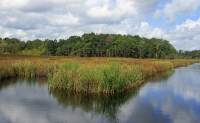
Caw Caw Interpretive Center and Charleston County Park
Set in the Caw Caw Swamp, the Caw Caw Interpretive Center is home to vast natural, cultural, and historical displays. Dating back to the 18th century, this formerly slave-worked rice paddy exhibits earthen dikes, rice trunks, and canals. Many species of animals and plants make their homes in the wildlife sanctuary, with a landscape of beech and holly forests servicing resident otters, frogs, squirrels, and more. Self-guided canoe trips are possible, as is cycling, hiking, and rock climbing. The park features six miles (9km) of walking trails, including elevated boardwalks through the wetlands where visitors can sometimes spot alligators creeping through the swamps. Birdwatchers will delight in searching for rare swallow-tailed kites and bald eagles.
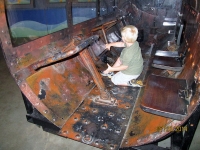
The Hunley
The Hunley was the world's first successful combat submarine, built on President Abraham Lincoln's orders during the Civil War. The submarine first arrived in Charleston by train 1863, proceeding to sink the warship USS Housatonic in 1864. During the attack, it sank and remained a mystery for many years. Modern navigation tools finally discovered the submarine in 1995, brought to land both for preservation and in order to piece together the history of the submarine's final hours. The submarine is now on display in a conservation tank at the Warren Lasch Conservation Center on the Cooper River. Visitors can see facial reconstructions of the Hunley crew, artefacts excavated from the submarine, and the legendary gold coin that supposedly saved the captain's life.
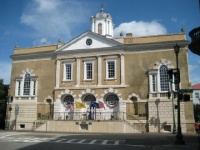
Provost Dungeon and Old Exchange Building
The British used Provost Dungeon for prisoners during the American Revolution. In 1774, the Old Exchange Building hosted the delegate elections for the First Continental Congress. Built in 1771, its original purpose was to assist with heavy import and export trade in Charleston. The Exchange was built in the Palladian style of architecture with a facade constructed from imported Portland stone. Having withstood war, earthquakes, and hurricanes, the building is strong. Part of the Half-Moon Bastion was excavated here and is the only visible section of the old Charlestown fort. Today, the South Carolina Daughters of the American Revolution run both the Old Exchange Building and the Provost Dungeon. All three floors of the main building are open to the public as a museum focused on the city's history and its role in American history. On tours through the dungeon, visitors are educated about the many pirates jailed during the 1800s. The Old Exchange Building regularly hosts symposiums on topics relating to Charleston's history, with the building also available to rent after hours as a function venue.
Getting Around
Charleston is fairly compact and it's easy to explore many attractions on foot or on a rented bicycle. To visit plantations and other attractions outside the city, hiring a car is the best option. A comprehensive and efficient bus service covers most areas in the city, operated by the Charleston Area Regional Transportation Authority (CARTA).
The most useful public transport for visitors is the tram system (DASH), offering free transport in the historic downtown area every day of the week. It's possible to reach many of the city's top attractions on the system. Taxis are available but must be called for; Lyft and Uber are available.
Charleston Climate and Weather
Charleston has a humid subtropical climate. Summer, between June and August, is hot and humid, with temperatures averaging between 70F (21C) and 91F (33C). The city's coastal situation helps to keep summers a bit cooler than inland.
Summer is also the wettest season, although Charleston receives significant rainfall throughout the year. Hurricanes are a threat in summer and early autumn. Winter, between December and February, is short and mild, with occasional snow flurries.
In the winter months, temperatures average between 38F (3C) and 62F (17C). Spring is generally a mild and pleasant season, perhaps better than summer because of the comfortably warm temperatures.
United States of America travel info
Electricity
The electrical current is 120 volts, 60Hz. Plugs are mainly the type with two flat pins, though three-pin plugs (two flat parallel pins and a rounded pin) are also widely used. European appliances without dual-voltage capabilities will require an adapter.
Language
English is the most common language spoken but Spanish is often heard in the south-western states.
Money
The official currency is the US Dollar (USD), which is divided into 100 cents. Only major banks exchange foreign currency. ATMs are widespread and credit cards are widely accepted; Apple Pay and Google Pay are very popular. Banking hours are Monday to Friday 9am to 3pm.
Tipping
A 15 percent tip is expected by taxi drivers, bartenders, hairdressers and waiters, but travellers shouldn't tip in fast-food or self-service restaurants. In expensive restaurants or for large parties, the tip should be 20 percent of the bill. It's normal to tip staff such as valets and porters in hotels; this is discretionary, although a minimum of $5 is expected. Most services are customarily tipped if the service is good.
Health
There are no specific health risks associated with travel within the USA. Medical facilities are excellent, but expensive. Only emergencies are treated without prior payment and treatment can be refused without evidence of insurance or proof of funds. Good medical insurance is essential.
Safety
Travel within the United States is generally trouble-free, though travellers should be aware that the US shares with the rest of the world an increased threat from terrorist incidents. Security has been heightened, particularly at airports. Restrictions on hand luggage apply and travellers are advised to check on the latest situation with airlines in advance. Travellers should also be alert to the dangers of car and street crime in cities and should use common sense and take basic precautions. Hurricanes are common between June and November, putting the southern USA, including the Gulf Coast and the eastern US at risk. There's a risk of wildfires in many dry areas in the US, particularly on the West Coast from March to November.
Local customs
Laws vary from state to state, including speed limit, fines and punishment. The age at which alcohol may be legally bought and consumed is 21 years.
Doing business
In such a large country, filled with so many diverse groups, business practices may differ according to each state, though rarely to any large degree. The East Coast is traditionally more formal than the West Coast, though in states such as California, dress code and conservative appearance are as common as they would be in New York. Punctuality is important throughout the country and it's considered rude to be late for a meeting. Gift-giving is uncommon as it may be construed as bribery. Appropriate titles (Mr, Mrs, Ms) are used upon introduction and until otherwise stated. Americans favour politeness and greetings of 'Hello' and 'How are you?' are often expressed with sincerity. Business hours may vary in each state, but an 8am start and 5pm finish Monday to Friday is the most common with an hour over lunch.
Status and age are not necessarily indicative of seniority, nor do they carry much weight in themselves. Those doing business in the States should be mindful of this fact; foreigners should never make assumptions about someone's position or rank. Best practice is to be respectful to all parties. That said, the US upholds a hierarchal business structure in which 'the boss' is the ultimate decision-maker. Senior leaders have the power of the last word, and can go against the grain just as easily as they can follow popular opinion. Foreigners should concentrate on winning over this individual, even if the greater group seems unsupportive. Americans value a direct style of communication. In this fast-paced, consumer culture 'time is money', and small-talk is viewed as unnecessary and wasteful. It's best for foreigners to get to the point quickly, speak about issues in a frank and open manner, and to avoid taking offence if someone questions or challenges them outright.
Duty free
Travellers to the United States who are returning residents of the country do not have to pay duty on articles purchased abroad to the value of $800 provided their stay was longer than 48 hours and their duty-free allowance was not used in the 30-day period prior. For passengers arriving from Samoa, Guam and the U.S. Virgin Islands, a duty-free allowance of $1,600 is allowed. The following items are included in this: 50 cigarettes and 10 cigars and 150 millilitres (5 fl. oz.) of alcoholic beverages or 150 millilitres (5 fl. oz.) of perfume containing alcohol. Restrictions may apply to goods from Cuba, Iran, North Korea, Burma (Myanmar), Angola, Liberia and Sudan. It is prohibited to import Cuban cigars from any country.
Travellers to the United States who are non-residents do not have to pay duty on the following items: 50 cigars or 200 cigarettes and gifts to the value of $100 provided their stay in the USA is not less than 72 hours and that the allowance has not been used in the preceding six-month period.
Prohibited items for residents and non-residents include meat or meat products, poultry, narcotics, absinthe, plants, seeds, vegetables, fruits, soil, live insects and other living plants or animal pests. Fish is prohibited unless it carries disease-free certification. Wildlife and animals or their by-products carry restrictions. Dairy products and eggs from specified countries are not allowed. Firearms and ammunition are not allowed without the necessary license and permit.
Communications
The international country dialling code for the United States is +1. Mobile networks cover most of the country, especially all urban areas; travellers can purchase local prepaid SIM cards for unlocked phones or use eSIMs if their cellular providers support it on their networks. WiFi is widely available.
Passport & Visa
It is highly recommended that travellers' passports have at least six months' validity remaining after the intended date of departure from them travel destination. A visa is required for short visits unless travellers qualify for entry under the Visa Waiver Program.
The Visa Waiver Program (VWP) enables citizens of certain countries to travel to the US for a stay of up to 90 days without a visa. Visitors under the VWP need a valid Electronic System for Travel Authorization (ESTA), which allows the US government to screen all visitors before travel. Visitors entering the country under the VWP must have a machine-readable passport (MRP) that has a barcode on the photo page. Travellers under the VWP must have passports that include biometrics if they wish to enter the country without a visa, which means that passports must contain unique personal data such as fingerprints or iris details. All passports must contain a digital photo image in order to travel visa-free. All visitors to the USA have a photograph and two fingerprints taken by an inkless scanner on arrival, including those travelling visa-free under the VWP.
As part of the Western Hemisphere Travel Initiative (WHTI), all travellers travelling between the United States and Canada, Mexico, Bermuda, and the Caribbean region are required to present a passport or other valid travel document to enter or re-enter the United States. If departing from the USA, a valid passport is required by immigration authorities. Immigration officials often apply different rules to those stated by travel agents and official sources.
Entry requirements
US citizens require passports.
UK nationals require a passport valid for duration of stay. Most passport holders can get an Electronic System for Travel Authorisation (ESTA) through the Visa Waiver Programme, which allows travel to the US for up to 90 days. The VWP includes tourism, certain types of business visit and transit to another country.
The most important requirement on entering the U.S. is providing proof of Canadian citizenship. A valid Canadian passport is the best document to prove Canadian citizenship and the right to return to Canada. However, several other documents can serve, depending on the mode of transport. Generally, Canadian citizens do not require visitor, business, transit or other visas to enter the United States from Canada, though there are some exceptions.
Passports must be valid for the period of intended stay. If visiting the US for fewer than 90 days, Australian nationals may be eligible to apply for an Electronic System for Travel Authorization (ESTA), and enter under the Visa Waiver Program (VWP).
South Africans must hold a passport valid for duration of stay. A visa is required.
Passports must be valid for duration of stay. Irish nationals can get an Electronic System for Travel Authorisation (ESTA) under the Visa Waiver Programme for entry into the United States.
Passports must be valid for duration of stay. New Zealand nationals can get an Electronic System for Travel Authorisation (ESTA) under the Visa Waiver Programme for entry into the United States.
Useful contacts
United States Tourist Office: www.usatourist.com
911 (General)Embassies / consulates in other countries
United States Embassy, London, United Kingdom: +44 20 7499 9000.
United States Embassy, Ottawa, Canada: +1 613 688 5335.
United States Embassy, Canberra, Australia: +61 2 6214 5600.
United States Embassy, Pretoria, South Africa: +27 12 431 4000.
United States Embassy, Dublin, Ireland: +353 1 668 8777.
United States Embassy, Wellington, New Zealand: +64 4 462 6000.
Embassies / consulates in United States of America
British Embassy, Washington DC: +1 202 588 6500.
Canadian Embassy, Washington DC: +1 202 682 1740.
Australian Embassy, Washington DC: +1 202 797 3000.
South African Embassy, Washington DC: +1 202 232 4400.
Irish Embassy, Washington DC: +1 202 462 3939.
New Zealand Embassy, Washington DC: +1 202 328 4800.


